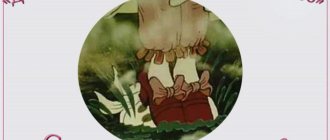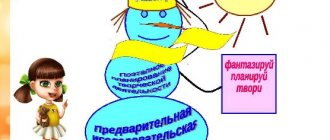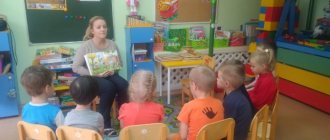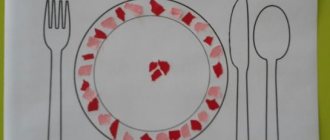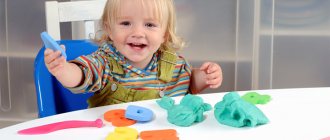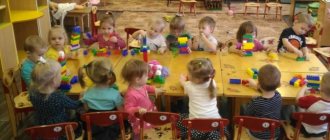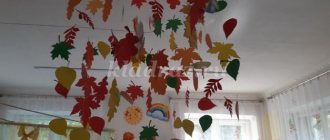CEP "Little Experiments" in the second junior group
Marina Votinova
CEP "Little Experiments" in the second junior group
Municipal budgetary preschool educational institution
"Kindergarten No. 96"
Perm
COP " Small Experiments "
(for children of the 2nd junior group , 3-4 years old)
Author : Votinova Marina Azatbaevna
Perm, 2018
Note for parents
A Chinese proverb says: “Tell me and I will forget, show me and I will remember, let me try and I will understand.”
A series of observations, experiences and experiments with water contributes to the formation of cognitive interest in children, the development of observation and emotionality in communicating with the outside world.
Everything is assimilated firmly and for a long time when the child hears, sees and does it himself. This is the basis for the active introduction of children's experimentation into the practice of working with children of primary preschool age.
This short-term educational practice promotes the development of independent experimentation and search activity of the children themselves.
Goal: To expand children's knowledge about water as an object of inanimate nature, its importance for human life, its role in the world around us, and about changes in water under different weather conditions.
Tasks:
1. Expand the knowledge of children of the 2nd junior group about water as an object of inanimate nature, its importance for human life, and its role in the world around us.
2. To introduce the physical and chemical properties of water in experimental activities .
3. Foster respect for water and economical use of water resources.
4. Clarify children’s ideas about the use of water to improve health.
5. Develop an aesthetic perception of water in nature.
Equipment:
1 Meeting: A container of water, one large and one small glass , two containers, a foam sponge.
2 Meeting: A bowl of water, two or three cans, wooden sticks.
3 Meeting: Containers with water (cold and warm, paint, stir sticks, measuring cups.
4 Meeting: Shaped molds and ice trays. Measuring containers with water of different temperatures (warm, cold, water level marked, snow, plates, measuring spoons (or scoops)
.
Number of meetings: 4
Number of participants: 10
Implementation period: February 2018
Expected Result:
The ability to use a sponge to transfer water from one dish to another; measure the water level by lowering a wooden stick into the jar; color water with different color intensities; convert water from liquid to solid.
Knowledge that water takes the shape of a vessel, that when you add paint to water, you can get multi-colored ice and make beautiful patterns out of it.
Knowledge about water as a substance that washes away dirt from hands.
№
Lesson Objectives Contents
1 Game with water: “Poured and poured”
,
"Wring out the washcloth"
Promote the development of coordination of movements and the development of fine motor skills, help expand the understanding of the properties of matter. Place a bowl of water in front of your child. Show how you can scoop up water in one glass and pour it into another. Fill one container with water. Show your child how you can use a sponge to transfer water from one dish to another.
2 Playing with water:
"Water-Carrier"
Introduce the properties of matter and the concept of volume, promote the development of coordination of movement. Invite the child to scoop water from a basin with different objects and pour it into different jars.
Compare with your child which jar contains more water.
Asking how to scoop up water will not work.
3 Playing with water:
"Water Coloring"
Assist in clarifying the properties of water: water can be warm and cold, some substances dissolve in water. The more of this substance, the more intense the color; The warmer the water, the faster the substance dissolves. Examine 2-3 objects in the water together with children, find out why they are clearly visible (the water is clear)
.
An adult offers to color the water themselves.
In which cup will the paint dissolve faster? How will the water color if there is more dye?
4 Playing with water:
“Transformations of water Interaction of water and snow”
“Your hands will become cleaner if you wash them with water.”
Promotes familiarization with the properties of the substance and helps to identify the properties of water: the higher its temperature, the faster the snow melts in it than in air. If you put ice, snow in water, or take it outside, it will become colder; check the ability of snow to turn into a liquid state under the influence of heat. Tell your child that water placed in the freezer freezes and turns into ice.
Demonstrate this clearly.
Show your child ice figures.
Watch the ice melt.
Offer to make sand figures using molds.
Draw children's attention to the fact that their hands have become dirty.
What to do?
How to clean sand from your hands? (Wash with water)
. The teacher suggests doing this.
Meeting summary 1:
A container of water, one large and one small glass ,
two containers, a foam sponge. Place a bowl of water in front of the child. Show how you can scoop up water in one glass and pour it into another.
Give the child freedom of action.
Fill one container with water. Show your child how you can use a sponge to transfer water from one dish to another.
Offer to try to do the same yourself. The ability to use a sponge to transfer water from one dish to another
Meeting summary 2:
Introduce the properties of matter and the concept of volume, promote the development of coordination of movement
A bowl of water, two or three cans, wooden sticks.
Place a bowl of water in front of the child. Place a teaspoon, a tablespoon, a ladle, a strainer, and a sponge nearby.
Invite the child to scoop water from the basin with different objects and pour it into different jars.
Compare with your child which jar contains more water.
Asking how to scoop up water will not work.
You can measure the depth of water in jars the way sailors once did: by lowering a wooden stick into the jar (though the sailors had a rope with a load)
.
The ability to measure water level by lowering a wooden stick into a jar
Meeting summary 3:
Assist in clarifying the properties of water: water can be warm and cold, some substances dissolve in water. The more of this substance, the more intense the color; The warmer the water, the faster the substance dissolves.
Containers with water (cold and warm, paint, stirring sticks, measuring cups.
Examine 2-3 objects in the water together with children, find out why they are clearly visible (the water is clear)
.
Together with the children, we determine how to color the water (add paint)
.
An adult offers to color the water themselves (in cups with warm and cold water)
.
In which cup will the paint dissolve faster? (In a glass of warm water)
.
How will the water color if there is more dye? (The water will become more colored)
.
Ability to color water with different color intensities
Meeting summary 4:
Promotes familiarization with the properties of a substance. Helps identify the properties of water: the higher its temperature, the faster the snow melts in it than in air. If you put ice, snow in water, or take it outside, it will become colder; check the ability of snow to turn into a liquid state under the influence of heat.
Shaped molds and ice trays. Measuring containers with water of different temperatures (warm, cold, water level marked, snow, plates, measuring spoons (or scoops)
.
Tell your child that water placed in the freezer freezes and turns into ice.
Demonstrate this clearly.
Show your child ice figures, draw his attention to the fact that the pieces of ice repeat the shape of the vessels that you filled with water.
Watch the ice melt.
By adding paint to water, you can get multi-colored ice and make beautiful patterns out of it.
Offer to make sand figures using molds.
Draw children's attention to the fact that their hands have become dirty.
What to do?
Maybe let's dust off our palms? Or shall we blow on them?
Are your palms clean?
How to clean sand from your hands? (Wash with water)
. The teacher suggests doing this.
Conclusion: What did we learn today? (Your hands will become cleaner if you wash them with water)
.
Ability to convert water from liquid to solid
Knowledge that water takes the shape of a vessel, that when you add paint to water, you can get multi-colored ice and make beautiful patterns out of it.
Knowledge about water as a substance that washes away dirt from hands
List of sources used
1. Poddyakov A.I. Combinatorial experimentation of preschool children with a multiconnected object - a “black box”
Questions of Psychology, 1990. No. 5.
2. Poddyakov N. N. Creativity and self-development of preschool children. Conceptual aspect. —Volgograd: Peremena, 1995.
3. Prokhorova L.K., Balakshina T.A. Children's experimentation is a way of understanding the world around them // Formation of the principles of ecological culture of preschool children (from the experience of kindergarten No. 15 “Podsolnushek”
Vladimir) / Ed. L. N. Prokhorova. — Vladimir, VOIUU, 2001.
4. Ryzhova P. Games with water and sand // Hoop, 1997. - No. 2.
5. Ryzhova N. Experiments with sand and clay // Hoop, 1998. - No. 2.
6. Tugusheva G. P., Chistyakova A. V. Game-experimentation for children of senior preschool age // Preschool pedagogy, 2001. - No. 1.
7. Fasius. I.M. Mastering the principle of preserving quantity and size by six-year-old children in the process of experimentation // Methodological advice for the “Childhood”
. - SPb.: CHILDREN'S PRESS, 200
